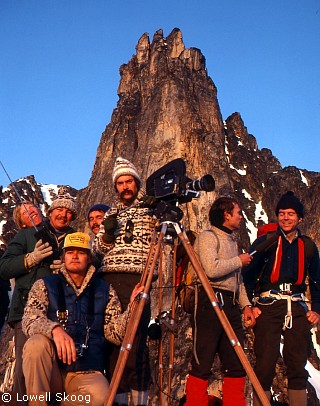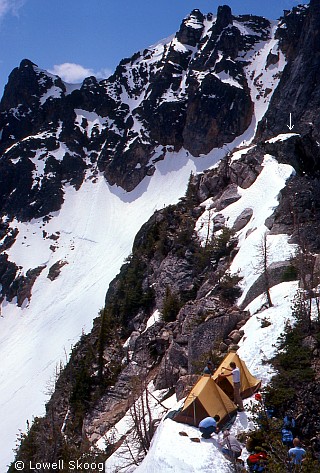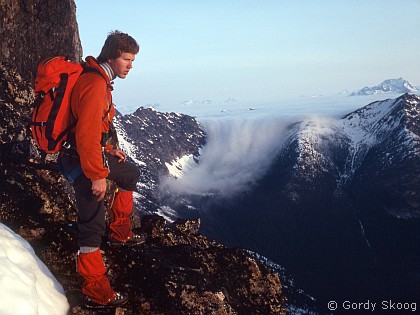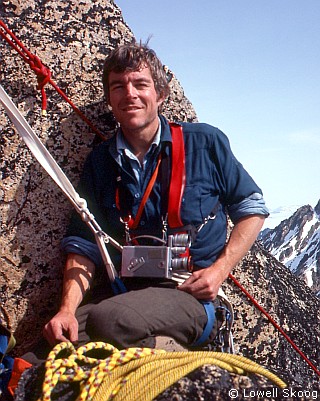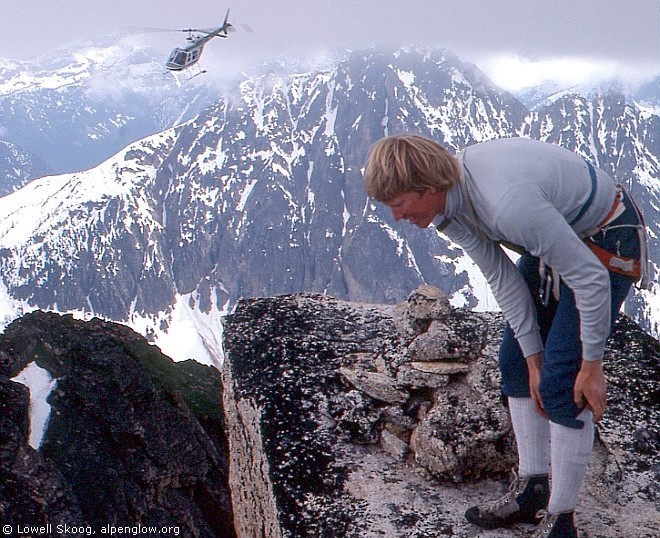
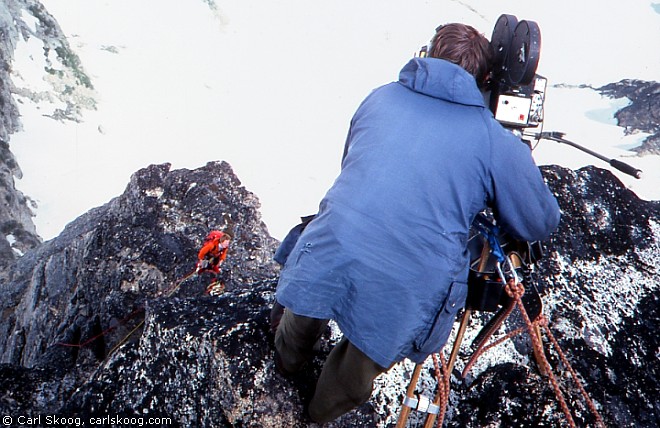
|
| Arlo Smith photographs Lowell leading the final pitch of Golden Horn's Northeast Arete. (Map 300kb, Route diagram) |
|
During the winter and spring of 1978-79, my brothers Gordy, Carl and I, with a few friends, filmed "Backcountry Ski Tour," a program about cross-country skiing for KOMO-TV's Exploration Northwest. The program aired the following winter and was judged a success by the TV station. Joel Schroedel, producer of Exploration Northwest, asked Gordy if he knew of a peak where they could film a program about rock climbing. The peak should be dramatic, but should not be located in a National Park or Wilderness Area, because of access restrictions.
Gordy knew just such a peak. In August 1979, four months after we finished filming the cross-country skiing program, Gordy and Jim Walseth made the first ascent of the Northeast Arete of Golden Horn, an 8366-ft crag in the North Cascades near Rainy Pass. Golden Horn lay outside the North Cascades National Park and the Pasayten Wilderness Area, in a section of Okanogan National Forest bordering the North Cascades Highway. Gordy's and Jim's 1979 climb was completed during a two-day trip from the highway which involved considerable cross-country travel through alpine terrain. There was no chance that the Exploration Northwest crew was going to traverse this country on foot with all their camera equipment. A helicopter would be required. Gordy looked for possible helicopter landing spots while the TV crew looked for a suitable pilot. In the weeks before the trip, we had three planning meetings in Seattle with the Exploration Northwest crew. Gordy and I would be the "stars" of the program, making the second ascent of Golden Horn's Northeast Arete. Lead cameraman Darrell Benedict would be at the base of the climb with sound-man Chris Raaum, producer Joel Schroedel, and host Don McCune. Darrell would film closeups of our approach to the climb as well as telephoto scenes of our ascent of the pinnacle. Since the TV crew members were not climbers, we brought in additional climbers to support the filming. Buzz Mersereau and Dave Anthony, two climbers I had not met before, joined the team as a climbing film crew. They would climb the Northeast Arete as a separate rope team, carrying hand-held cameras to get closeup footage of Gordy and me climbing. My brother Carl and our friend Jens Kieler (then Kuljurgis) would be at the summit of Golden Horn to support KOMO-TV cameraman Arlo Smith. When we were low on the mountain, Arlo would film us from the Southeast Ridge, which offered a profile view of the route. As we neared the top, Arlo and company would move just below the summit, where they could look down at us finishing the route. (For route diagram, click here.) On Thursday, June 12, 1980, we converged at Sun Mountain Lodge near Winthrop, Washington. The weather had been bad for three straight weeks, but the forecast called for slow improvement. We encountered mist and fog while driving over Rainy Pass on the North Cascades Highway, but when we awoke Friday morning at Sun Mountain Lodge, the skies were clear. Joel Schroedel called the helicopter pilot at 6 a.m. We drove to our pre-arranged staging point at the Cutthroat Creek picnic area, about five miles (as the crow flies) from Golden Horn.
We unloaded and sorted gear, waited and wondered about the weather. Suddenly the helicopter arrived, a four-passenger Bell Jet Ranger flown by Lon Stickney with Arlo Smith aboard. Joel told us that Stickney had been a helicopter pilot in the Vietnam War. The first thing Stickney did after getting out of the helicopter was to curse himself for not latching the cargo door properly. He had flown all the way from Seattle to the North Cascades with the door open and swinging in the breeze. Fortunately it appeared undamaged. The pilot briefed us on helicopter safety then loaded Gordy and Joel aboard with no additional gear. They flew to a point on the Northeast Ridge of Golden Horn at about 7400 feet elevation. The landing spot was a knob of snow ten-to-fifteen feet across perched atop a minor bump on the ridge. The ridge dropped away for hundreds of feet on either side. Although both Joel and the pilot had been warned that the landing site might be airy, neither was fully prepared for what they found. Stickney touched the helicopter down on the snow, maintaining full power as he bouncing the aircraft gently to pack down a platform under the skids. Turning to Joel, the pilot said, "Well, do you want to get out?" "Sure do," said Joel. He shot a glance at Gordy. "You better go first," he said. Looking around once more and taking a deep breath, Joel added, "Skoog, you sure know how to pick 'em!" After unloading Gordy and Joel, Stickney flew back to the staging area to pick up two more passengers and some gear. "Boy you're gonna love this [landing] spot," he told Buzz and Dave as they climbed aboard. Next to go were Chris and Darrell with more gear. Then Don McCune with still more gear. Finally, it was my turn. From the parking lot, we climbed northeast, turned a shoulder and flew west up Pine Creek. After we crossed a 6401-ft pass, I scrambled to take photos of the sheer Northeast Face of Tower Mountain, which had not yet been climbed. We flew over another 6840-ft pass and I marveled at our intended route, which looked intimidating from the air. Stickney dropped me off near our campsite, then shuttled Arlo, Carl and Jens in two flights to the Southeast Ridge, close to the summit of Golden Horn. The summit flights were made last so that the helicopter, having burned a lot of fuel, would be as light as possible. (For map, click here.)
We set up camp and did little else that day because it started raining again. Jens checked out camera locations near the top then descended a snow gully east of the summit to our basecamp. Saturday morning brought mostly clear skies, but with a thickening haze. Darrell filmed Gordy and me talking about climbing gear with Don McCune, then hiking to the base of the route. Gordy and I were outfitted with wireless microphones. As we belayed a few moves to the base of the first long pitch, I sang a song we'd made up on a previous trip, to the tune of Monty Python's "Oh, I am a Lumberjack": Oh, I am a mountaineer and I'm okay. I led the first pitch without much trouble, fixed a rope, and waited. As Dave struggled to jumar the rope, it started to sprinkle. We changed our plans. Rather than wait for Dave and Buzz to follow the first lead, Gordy climbed up to me and immediately started leading the next pitch. Darrell would film from below. The rain stopped for a short time. We gave the rock a few minutes to dry, but it didn't help much. The rain resumed and Gordy completed the lead on wet, lichen covered rock -- slow, difficult and very slippery. I found the pitch very delicate to follow. We fixed a second rope and rapelled back to the base. It was raining steadily now. Darrell had gotten some telephoto shots with good sound, so all was not lost. We spent the afternoon in our tents telling riddles and jokes on the walkie-talkies. Jens and Dave Anthony climbed to the summit camp to join Arlo and Carl. Late in the day, when the weather improved, we emerged from our tents to film a fake bivouac scene. Having been thwarted two pitches up the climb by rain, we decided that a weather-induced bivouac would provide a logical break in the TV story. As we settled back into our tents for the night, I thought the weather was a goner.
On Sunday morning we awoke at 4 a.m. to clear skies. After eating and getting organized, Gordy, Buzz and I scrambled to the base of the route at 5:30 a.m. We had decided to make the climb with a party of three rather than two separate rope teams. Dave, Jens and Carl would stay on the summit to support Arlo. Having climbed Liberty Crack near Washington Pass a few weeks earlier, I had the most recent jumaring practice, so I led the way up the fixed ropes. Jumaring the vertical rope wearing a pack was difficult. The lichened rock on the second pitch was still wet. I later wrote in my journal, "The rope is wet and the rock is pure slime. Had we not fixed it before, all would be lost." From the "bivi ledge" atop the second pitch I could see Arlo, tied securely to the mountain, peering down at us from the near summit. What a vantage point! Buzz filmed me leading the third pitch. After climbing up on my belay, he filmed Gordy following. Buzz hid from Arlo's camera as Gordy led the fourth pitch. We encountered considerable loose rock on the third and fourth pitches and Arlo filmed a shower of small rocks that Gordy loosened, one of which bounced off my head. There is no question that today I would wear a helmet on a climb like this, but Gordy, Buzz and I did not have them on Golden Horn. Neglecting the short approach pitch at the start of the climb, the Northeast Arete consists of five roped pitches and is rated Grade III, class 5.8. We climbed on a 50m rope, but a 60m rope would be better for reaching good belays. Gary Brill made the third ascent of the route after our KOMO-TV climb and found the rock insecure and potentially dangerous. As a result, Fred Beckey's Cascade Alpine Guide says about the climb: "Later ascent parties have given most of the route a shaky rating, despite the classic appearance. There are numerous fragile flakes of dubious stability; protection is sometimes insecure." I can't argue with that assessment.
The fifth and final pitch was relatively easy and Arlo was able to film closeup scenes of us completing the pitch and unroping. He followed us as we scrambled to the summit block and filmed our summit handshake. In an amazing stroke of luck, Lon Stickney returned from Seattle with the helicopter just as we were filming these summit scenes. He picked up Darrell Benedict from the base and flew him around the summit with the window open and the camera rolling. Around and around they flew, capturing the most dramatic scenes of the trip. Gordy and I stood on the summit and admired the view as the camera whirled around us. In the finished program, Carl and Arlo can be seen crouching (like lumps of snow) just below the summit block. We hurriedly gathered our gear and Lon Stickney began ferrying us back to the parking lot in the helicopter. In my journal I described my flight as "a roller-coaster ride in the rain." A forest ranger appeared at the parking lot and demanded to know who we were and what we were doing there. Thanks to Joel Schroedel and Don McCune, ruffled feathers were soon smoothed out. Hands were shaken, stories retold, cars packed, and soon we were headed for home. Carl got to ride all the way to Seattle in the helicopter. Later that summer we learned that Exploration Northwest had been cancelled by KOMO-TV after twenty years on the air. The Golden Horn program was eventually finished and it has aired many times over the years as a special. Joel Schroedel won an Emmy award for his editing. "Goldenhorn Pinnacle" - Climbers: Gordy and Lowell Skoog. Support crew: Jens (Kuljurgis) Kieler, Carl Skoog. Photographed by Darrell Benedict, Arlo Smith, Buzz Mersereau, Dave Anthony. Edited by Joel Schroedel. Sound recording by Chris Raaum. Sound editing by Joel Schroedel. Written and narrated by Don McCune. Producer: Joel Schroedel. Executive producer: Patrick Scott. A production of KOMO-TV. © 1980, Fisher Broadcasting Inc. Copies of this program can be purchased on DVD from The Don McCune Library. --Lowell Skoog, December 2007
|
The Alpenglow Gallery
